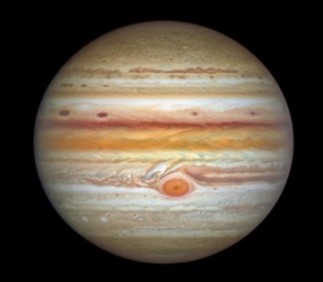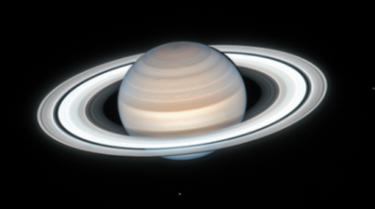
Jupiter and Saturn are in essence failed stars. Consisting mainly of hydrogen and helium gas, the primary building blocks of all stars, neither planet was massive enough to ignite a thermonuclear reaction at its core (lucky for us).
Jupiter
- Fifth planet from the sun
- If the sun is at a football field’s goal post and Earth is on the two-yard line, Jupiter is at the 10.5-yard line
- Biggest planet, 1300 Earths could fit inside
- Brightest planet
- Rotates on its axis in 9.97 hours. Takes 11.6 years to orbit the sun
- Takes sunlight 43 minutes to get there
- Lacks a hard surface. Mean temperature: -110 degrees Celsius
- Has 95 moons; its biggest moon Ganymede is larger than Mercury
- Has four rings but they are faint and difficult to see
- Stormy atmosphere with wind speeds over 500 km/hr
- In July of 1994, Shoemaker Levy 9 was a comet that ventured too close to Jupiter and was torn apart by the planet’s powerful gravitational field. The comet’s demise highlighted Jupiter’s role in protecting the inner planets from space debris by acting as a “cosmic vacuum cleaner”.

Saturn
- Sixth planet from the sun
- If the sun is at a football field’s goal post and Earth is on the two-yard line, Saturn is at the 19-yard line
- Second largest planet, 764 Earths could fit inside
- Not as bright as Jupiter who follows it across the southern sky each fall
- Rotates on its axis in 10.7 hours. Takes 29.4 years to orbit the sun
- Takes sunlight 1.5 hours to get there
- Lacks a hard surface. Mean temperature: -140 degrees Celsius
- Has 146 moons; its largest moon Titan, is also bigger than Mercury
- Has seven beautiful rings made of 95% water ice; same as Saturn’s moons
- Stormier than Jupiter with wind speeds over 1800 km/hr


